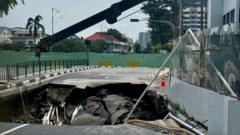A recent emergency sparked by a 3m deep sinkhole in Singapore has shed light on the often-overlooked plight of migrant workers in the city-state. The incident occurred when a woman’s car fell into the hole, drawing immediate attention from a group of seven Indian construction workers nearby. With quick thinking and teamwork, the workers secured a rope and successfully pulled the woman to safety within minutes. Foreman Suppiah Pitchai Udaiyappan, one of the rescuers, emphasized the urgency of saving the woman amidst the chaos.
This act of heroism quickly circulated on social media, eliciting widespread appreciation for the workers, who represent a significant demographic within Singapore’s labor force. Many migrant workers in Singapore hail from countries like India, Bangladesh, and Myanmar, comprising a crucial segment of the economy, where they often engage in low-wage, labor-intensive jobs that local residents avoid.
While this incident has brought a momentary spotlight on their contributions, it has also reopened debates concerning the rights and treatment of these workers. With the absence of a minimum wage in Singapore, many earn as little as S$300 a month. Moreover, they face poor living conditions in overcrowded dormitories and experience a range of abuses including overwork and unpaid wages.
The living conditions of migrant workers were starkly highlighted during the COVID-19 pandemic, revealing the vulnerabilities they endure. Reshaping public discussion, the sinkhole event has again raised issues such as the unsafe transportation methods used to ferry workers to job sites—often packed into flat-bed trucks, a dangerous and exploitative practice still permitted under certain labor laws.
Activists have long advocated for a ban on such transportation, pointing to the increased risks evidenced by fatal accidents. Despite recommendations for better transport options, the government has been hesitant to enact sweeping changes, arguing that such a ban could harm small businesses. Advocacy groups assert this rationale places excessive power in the hands of employers, often at the expense of migrant workers’ rights and welfare.
In recognition of their bravery, the rescuers were awarded commemorative coins, with some officials praising their role in enhancing societal safety. However, this gesture has been criticized by activists, who argue it reflects a trend of tokenism devoid of substantive change. Calls for further acknowledgment include appeals for financial rewards and pathways to permanent residency for long-serving workers—requests the government has yet to fully address.
Despite accumulating awareness of their circumstances, deep-seated societal divides and perceptions of inferiority towards migrant workers persist. While some community initiatives have successfully fostered connections between migrant laborers and local residents, significant barriers remain, and many continue to view these workers as a separate class—servants expected to assist without reciprocal recognition.
As Singapore grapples with its identity and the foundation of its workforce, the debate surrounding the rights of migrant workers continues, becoming ever more urgent against the backdrop of recent events.



















